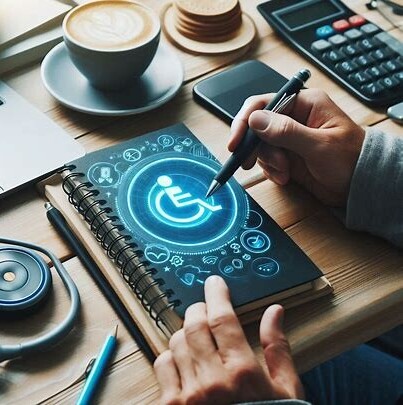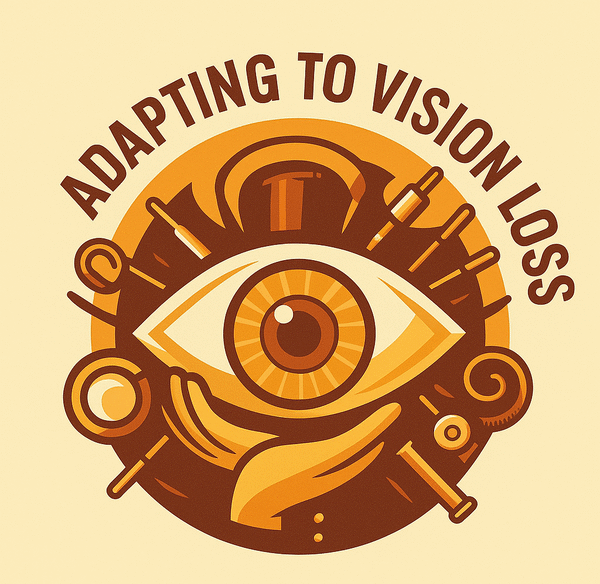
When I first encountered the challenges of navigating a world not built with vision loss in mind, I found a lifeline in assistive technology. Embracing these innovations has not only made everyday tasks manageable but has also sparked a renewed sense of independence. This narrative explores the transformative power of assistive technology, blending personal insights with practical tips along the way.
Understanding the Landscape of Assistive Technology
I quickly discovered that assistive technology covers a broad spectrum of devices and software, each designed to open new doors of possibility. It’s fascinating how innovations—once the stuff of science fiction—have become essential tools in my daily life. For instance, I found that:
- Screen Readers: Programs like VoiceOver and NVDA convert text into speech, transforming digital content into an auditory experience.
- Magnification Software: Tools such as ZoomText enlarge text and images, allowing me to see details I might otherwise miss.
- Braille Displays: These devices convert digital text into tactile Braille, offering a hands-on approach to accessing written information.
These tools are more than just gadgets—they are bridges that connect me to a world of information and opportunities.
Embracing Digital Accessibility
The digital world can seem overwhelming, but with the right technology, it becomes an accessible and engaging space. I learned to navigate websites, emails, and documents with the help of innovative solutions that adapt to my needs. Consider how technology now makes digital content more reachable:
- Voice-Activated Commands: With assistants like Siri, Google Assistant, and Alexa, controlling my digital environment is as simple as speaking a command.
- Speech-to-Text Solutions: These tools effortlessly convert my spoken words into text, making communication and documentation smoother.
- Customizable Interfaces: High-contrast modes and adjustable font sizes mean that digital interfaces can be tailored to suit my visual requirements.
Integrating these features into my daily routine has truly transformed how I interact with the online world.
Transforming the Home Environment
Assistive technology isn’t confined to the digital realm; it has a profound impact on how I live at home, too. Smart home devices have redefined what it means to have a safe, responsive living space. My home now feels like a sanctuary that adapts to my needs, thanks to:
- Voice-Activated Assistants: Devices like Amazon Alexa and Google Home allow me to control lighting, adjust thermostats, and even play my favorite audiobooks with a simple voice command.
- Connected Appliances: Modern appliances come equipped with tactile buttons and auditory alerts, making everyday tasks more accessible.
- Automated Systems: From security systems to environmental controls, automation helps create a predictable and secure home environment.
These innovations have turned my home into a space where independence is woven into every corner.
Navigational Tools and Wearables
Venturing outside the comfort of home presents its own set of challenges, but navigational technology has been a game changer for me. With tools designed to guide me safely through unfamiliar areas, I can explore with confidence. Key innovations include:
- GPS-Based Navigation Apps: These specialized apps provide real-time auditory directions and obstacle alerts, ensuring I stay on track.
- Wearable Sensors: Devices like smart glasses and sensor-equipped wearables alert me to nearby obstacles, enhancing my safety on the go.
- Location-Based Services: Many apps now offer detailed information on public transportation and accessible routes, making each outing more predictable.
With these tools, even a simple trip to a new part of town becomes an opportunity for adventure and discovery.
Tips for Integrating Assistive Technology
Adopting assistive technology is a journey of its own, one that requires patience and practice. Here are some strategies that helped me integrate these tools into my life:
- Start Small: Begin with one tool to build familiarity and confidence before gradually adding more.
- Seek Expert Guidance: Consult with specialists or join support groups to get tailored advice that suits your unique needs.
- Practice Regularly: Consistent use is key to making these tools feel like an extension of yourself.
- Stay Open to Innovation: Technology evolves rapidly, so keeping an eye on the latest advancements ensures you benefit from new features and improvements.
Each of these steps has helped me not only adapt but thrive in an ever-changing technological landscape.
Personal Reflections and Stories
My journey with assistive technology has been filled with moments of discovery and empowerment. I still remember the first time a screen reader transformed an entire article into spoken words—it was as if a new world had opened before me. Similarly, integrating smart home devices into my daily routine gave me back a sense of control over my environment. These experiences remind me that every new tool is not just a device, but a gateway to greater independence.
Conclusion
Leveraging assistive technology is more than a practical solution—it’s a pathway to a more connected, independent life. By embracing digital accessibility, transforming my home environment, and confidently navigating the world with cutting-edge tools, I have found new ways to reclaim my independence. Each innovation serves as a reminder that technology, when embraced with an open mind, can be a powerful ally on your journey to a more empowered and fulfilling future. Embrace these tools, explore their possibilities, and let them guide you toward a life defined by freedom and resilience.
You said:
If possible please expand some of the bulleted text
Reasoned for a couple of seconds
Leveraging Assistive Technology: Enhancing Independence Through Innovation
When I first encountered the challenges of navigating a world designed primarily for sighted individuals, I found a lifeline in assistive technology. Embracing these innovations has not only made everyday tasks more manageable but has also sparked a renewed sense of independence. In this narrative, I share my journey through the transformative landscape of assistive technology, blending personal insights with practical strategies to illustrate its profound impact.
Understanding the Landscape of Assistive Technology
Assistive technology encompasses a diverse range of devices and software designed to open new doors for individuals with vision loss. These tools have revolutionized the way I interact with information and the world around me. Consider the following:
- Screen Readers:
Programs like VoiceOver and NVDA convert digital text into spoken words, enabling you to “hear” written content. This technology transforms websites, documents, and emails into accessible audio, allowing you to absorb information without needing to rely on visual cues. - Magnification Software:
Tools such as ZoomText enlarge text and images on your screen. By increasing the size of content, these programs help you discern details that might otherwise be lost, making digital and printed material more accessible. - Braille Displays:
These devices translate digital text into tactile Braille. By converting what appears on a computer or smartphone screen into raised dots, Braille displays provide a hands-on way to read and interact with information, ensuring that you have access to the written word in a format that suits you.
Each of these technologies has become an indispensable part of my daily life, bridging the gap between my needs and the vast array of available information.
Embracing Digital Accessibility
The digital world can be overwhelming, but assistive technology has redefined how accessible online content can be. With the right tools, I’ve been able to transform the way I engage with digital media:
- Voice-Activated Commands:
With assistants like Siri, Google Assistant, and Alexa, controlling my digital environment has become intuitive. Whether it’s sending a text, setting reminders, or searching for information, simply speaking a command allows me to interact with technology effortlessly. - Speech-to-Text Solutions:
These programs take my spoken words and convert them into written text. This capability streamlines communication, making it easier to compose emails, messages, or even documents, without the need for traditional typing. - Customizable Interfaces:
Modern devices offer high-contrast modes, adjustable font sizes, and customizable color schemes that adapt to my visual preferences. These features ensure that every digital interface is tailored to enhance readability and comfort, making prolonged use less straining on the eyes.
Incorporating these digital tools into my routine has transformed what once felt like an intimidating online world into a space of endless possibilities.
Transforming the Home Environment
Assistive technology also plays a vital role in creating a safe and adaptive home environment. Smart home innovations have redefined my living space, making it a sanctuary that responds to my unique needs:
- Voice-Activated Assistants:
Devices like Amazon Alexa and Google Home empower me to control household functions effortlessly. With a simple voice command, I can adjust the lighting, change the temperature, or even play my favorite audiobooks. This hands-free operation adds a layer of convenience and safety that traditional controls simply cannot match. - Connected Appliances:
Modern appliances now come with tactile buttons and auditory signals. For example, a refrigerator might announce when the temperature changes, or a microwave might use distinct sounds to signal that a cycle is complete. These features ensure that everyday tasks are performed with greater ease and awareness. - Automated Systems:
Home automation systems—ranging from security cameras to climate control—work seamlessly to create an environment that feels both secure and responsive. By integrating these technologies, my home becomes a space where I can move freely and confidently, knowing that each system is attuned to my needs.
By transforming my living space with these innovations, I have created an environment that not only supports my daily routines but also fosters a strong sense of independence.
Navigational Tools and Wearables
Venturing outside the home presents its own set of challenges, yet assistive technology continues to pave the way for safe and confident exploration:
- GPS-Based Navigation Apps:
Specialized apps designed for the visually impaired provide real-time auditory directions. They alert me to upcoming turns and potential obstacles, ensuring that even unfamiliar routes become navigable with clarity and precision. - Wearable Sensors:
Devices like smart glasses and sensor-equipped wearables are invaluable for detecting obstacles in real time. These gadgets provide immediate feedback, alerting me to objects or changes in my surroundings, which is especially useful in crowded or unpredictable environments. - Location-Based Services:
Many modern apps offer detailed information about public transportation, accessible pathways, and nearby amenities. This information not only makes travel more efficient but also empowers me to plan outings with greater confidence, knowing that each step of the journey is supported by technology.
With these tools at my disposal, even a simple walk in a new neighborhood transforms into an opportunity for exploration and self-reliance.
Tips for Integrating Assistive Technology
Adopting assistive technology into your daily life is a journey that requires patience and experimentation. Here are some strategies that have helped me integrate these tools effectively:
- Start Small:
Begin with one tool—perhaps a screen reader or a voice-activated assistant—to gradually build familiarity. Introducing technology in manageable increments allows you to develop confidence before expanding your toolkit. - Seek Expert Guidance:
Connecting with specialists or joining support groups can provide personalized advice and troubleshooting tips. These experts understand the nuances of assistive technology and can tailor recommendations to your specific needs. - Practice Regularly:
Consistent use is essential. As you integrate each tool into your routine, regular practice helps ensure that the technology becomes a natural extension of your daily life. - Stay Open to Innovation:
Technology is ever-evolving, and staying informed about the latest advancements ensures that you continue to benefit from new features and improvements. Embracing innovation can lead to unexpected opportunities to enhance your independence further.
Each of these tips has served as a stepping stone on my journey, helping me harness the full potential of assistive technology.
Personal Reflections and Stories
My journey with assistive technology is marked by moments of discovery and empowerment. I vividly remember the first time a screen reader brought an article to life through spoken words—it was as if a new door had opened, revealing a world of information previously hidden from me. Similarly, when I integrated smart home devices, I felt a profound sense of control over my environment that I had never experienced before. These experiences remind me that every technological innovation is not just a tool, but a bridge to greater freedom and self-reliance.
Conclusion
Leveraging assistive technology is more than a practical solution—it is a transformative pathway to independence. By embracing digital accessibility, reimagining your home environment, and confidently navigating the world with advanced tools, you can reclaim a sense of autonomy and self-assurance. Each innovation, whether a screen reader, a voice-activated assistant, or a navigational app, plays a pivotal role in supporting your journey. Embrace these tools, explore their possibilities, and let them guide you toward a future defined by freedom, resilience, and continuous growth.

